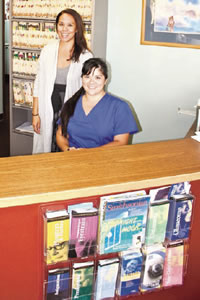An Eye On Ocular Health

Dr. Gandia (standing) with assistant Mandi Lockwood. Amanda C. Gregg photo
Dr. Derelyne Gandia
Optometrist
Interviewed By Amanda C. Gregg
What was your life before being an optometrist? Fun. While at University of California at Santa Barbara, I developed awesome friendships and a love for surfing. My friends and I would travel all over the California coast, Mexico, Central America and Europe for surf and cultural experiences. I was 20 years old and living in Santa Barbara. I was running, hiking, practicing yoga and living it up with my best friends. Life was (and is) wonderful.
When and why did you decide to be an optometrist? My initial exposure to the profession of optometry was as a vision therapist. Working under a behavioral optometrist, I learned that although someone can have 20/20 eyesight, if the eyes did not team accurately and effectively, information got lost. In the classroom, 70 percent of what is learned is through vision. As a vision therapist, I worked with kids who were below reading level or struggling in school, people with recent brain trauma, and athletes to improve their binocular and perceptual performances. The outcome, especially with kids, was astounding and a positive life-changer for them. I knew if I ever made it back home, I had something different to offer optometry on Kaua’i. This was when I decided to go into optometry.
You’ve moved locations recently. Please tell us about how long you’ve had your practice and where it is now located? When I moved back to Kaua’i four years ago, I practiced with Glenn Belisle, O.D., a really great guy. He had two office locations, and I worked in both his Kapa’a and Lihu’e locations. I purchased the Lihu’e location and now practice as Garden Island Eye Care. We recently celebrated our one-year anniversary. I have a lot of heartfelt gratitude to everyone who supported us during our transition and for their continued loyalty and patronage.
What are the most essential reasons to have consistent eye care? At the end of your exam, you might hear your eye-care practitioner call out, “See you next year!” and in your mind you think, “I’ll see you when my contact lens prescription runs out or my glasses break,” which may be a few years from now. No. We want to see you sooner. The most debilitating vision loss progresses slowly over time. Symptoms may be subtle or go unnoticed. Consistent eye care is a must to maintain good eyesight to last a lifetime.
What are some examples of screenings that your office handles? We screen for neurological vision loss, glaucoma, ocular inflammation, ocular systemic disease (diabetes, hypertension, etc.), cataracts, dry eyes, color vision, depth perception and refractive errors. In addition, we screen for accommodation disorders (the eye’s ability to keep a target in focus with varying or sustained distances), vergence disorders (the eye’s ability to turn in and out to keep singularity at different distance without suppression of one eye) and ocular motor function (how efficiently the eyes move from one target to another). Also, at the end of my exams, there’s a discussion about preventative health care. We review foods and supplements that benefit the eyes and foods or preservatives that may cause ocular inflammation, like dry eyes or allergies. We discuss how certain medications affect our eyes. Avid readers or computer users are advised to look off in the distance every 15 minutes of sustained near work for 15-60 seconds, make purposeful blinks to lubricate the eyes or supplement with lubricating eye drops. Ergonomics and work space design are discussed. Everyone on Kaua’i needs sunglasses.
How often should a patient be examined? Listen to your eye-care practitioner. Every ocular condition is specific and may need more frequent visits. In general, an annual eye exam should be the rule. You shouldn’t go more than a year without visiting your eye-care doctor if you have diabetes, dry eyes, wear contact lenses or have any other ocular condition that needs monitoring. I strongly believe that anyone in school, preschool to college, should have annual eye exams because, as I said, 70 percent of classroom learning is visual, and with the technology becoming a mainstay, we become ever more dependent on our eyes for information.
At what age should a patient have his/her first visit? The first eye exam should be before your child’s first birthday. This exam screens for media opacities, congenital eye disease, significant refractive error, or strabismus that may affect visual development. Your child should have a second eye exam at age 3, as a child heads into preschool with new visual experience. If you or your child has never had an eye exam, now is a good time to start.
What do you do for fun?
Fun now is not so much different than fun in my 20s, minus the traveling and the addition of a little more Zumba.
Garden Island Eye Care Inc.
Dr. Derelyne Gandia Park Plaza II 4414 Kukui Grove St. Ste. 101
Lihue, HI 96766 632-2020



